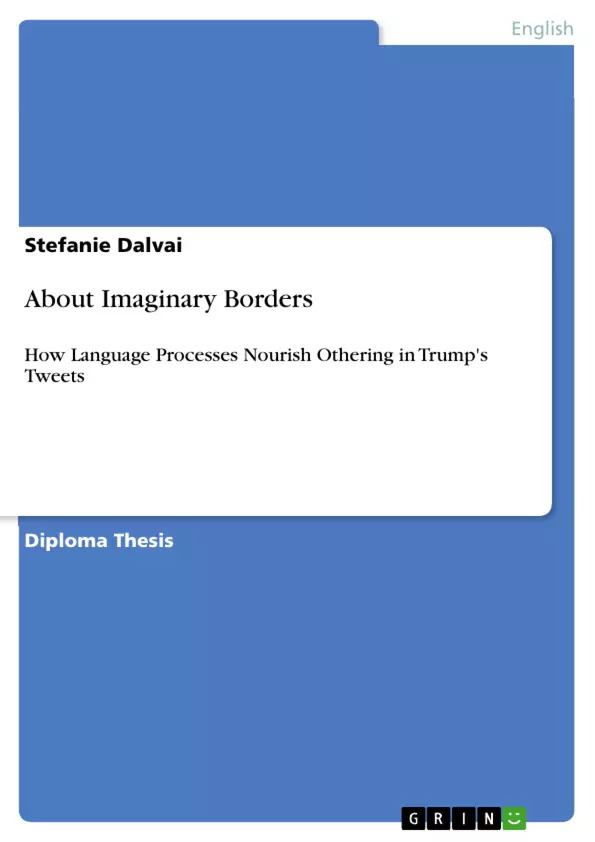Othering is a language process which does not only occur in spoken language, but also in written. Nowadays, such a negative portrayal and creation of the perfect other is often happening in a rather hidden and indirect manner. This paper explores whether Donald J. Trump indulged in the act of Othering in his Tweets, and whether this happened in a direct or indirect way. The findings lead to an understanding whether Othering is being accepted in politics or not.
What comes as a blessing has also its downsides, as not only positive but also negative opinions are omnipresent on the internet. This is due to the possibility to upload almost everything, as not every website has a way to censor inappropriate content. Furthermore, having a filter for written or pictured hate crime does not prevent it from happening as it is not always straight forward, and hateful messages can come in disguise.
An uncountable number of these more or less hidden hate crimes are a sort of 'Othering' as people tend to put themselves in opposition to others to create a sense of solidarity with those who share sameness and to have some excuse to keep up power relationships. With this, it becomes clear that language itself, in the case of this paper explicitly the written one, is a powerful tool to exert authority and domination on others, especially when used by people in power, like politicians.
Therefore, the question this paper tries to answer is how written discourse in the Tweets of Trump creates the feeling of separation and dominance that underlies the act of 'Othering' and whether this reflects a direct or indirect, and with this more subtle and normalized, use of power discourse. In this thesis, only those people Trump constantly portrays as dangerous foreigners, intruders, therefore not 'Americans', are included in the analysis, by looking at how he structures his discourse around them. These include Mexicans and Muslims, both to be found under the umbrella term of (illegal) immigrants.
Inhaltsverzeichnis (Table of Contents)
- Introduction
- The Power of Language
- The Connection between Language and Society
- Written Discourse as a Specific Type of Discourse
- Social Media and Twitter
- Donald Trump
- Donald J. Trump
- A Short Overview on Trump's Presidential Career
- Trump's Immigration Policy
- Ideologies and Fears Surrounding Othering
- Patriotism
- American Exceptionalism
- Islamophobia
- Othering
- Historical Background and Definition
- Mechanisms of Othering
- Reasons onto which Othering is being justified
- Repercussions of Othering
- Analysis Process explained
- CDA
- Software used
- Three Levels of Analysis
- Description Level Explained
- Interpretation Level Explained
- Explanation Level Explained
- Analysis
- Description Level
- Immigrant, Illegals, Refugee: How Are Others Portrayed Linguistically
- Immigrant, Illegals, Refugee: How Are the Others Divided Linguistically
- Immigrant, Illegals, Refugee: How Are Power Relations Sustained
- Hispanic, Mexican: How Are Others Portrayed Linguistically
- Hispanic, Mexican: How Are the Others Divided Linguistically
- Hispanic, Mexican: How Are Power Relations Sustained
- Islam, Muslim: How Are Others Portrayed Linguistically
- Islam, Muslim: How Are the Others Divided Linguistically
- Islam, Muslim: How Are Power Relations Sustained
- Interpretation Level
- How Are the Others Portrayed Linguistically
- How Are the Others Divided Linguistically
- How Are Power Relations Sustained
- Explanation Level
- Description Level
Zielsetzung und Themenschwerpunkte (Objectives and Key Themes)
This paper analyzes the language Donald Trump uses in his Tweets to understand how it contributes to the creation of an "other." The objective is to explore the mechanisms of othering through a Critical Discourse Analysis (CDA) framework, focusing on Trump's portrayal of immigrants, Mexicans, and Muslims in his tweets.
- The role of language in shaping social perceptions
- The dynamics of othering and its impact on social relations
- The relationship between power, language, and ideology
- The influence of social media on political discourse
- The specific case of Donald Trump and his language use
Zusammenfassung der Kapitel (Chapter Summaries)
The introduction sets the context for the study, highlighting the increasing visibility of human rights issues in the age of the Internet. It also emphasizes the potential of language to exert authority and domination, especially when wielded by powerful individuals like politicians. The chapter delves into the historical background and definition of "othering," exploring its mechanisms and the reasons for its justification. The analysis of Donald Trump's language use focuses on the portrayal of immigrants, Mexicans, and Muslims in his tweets. It investigates how language creates divisions, reinforces power relations, and contributes to the construction of an "other." The study concludes with an analysis of the specific language used by Donald Trump in his tweets to dehumanize and exclude certain groups.
Schlüsselwörter (Keywords)
The paper focuses on the keywords "othering," "language," "discourse," "power," "ideology," "social media," "Donald Trump," "immigration," "Mexicans," "Muslims," and "Critical Discourse Analysis (CDA)." These terms encompass the core themes of the study and provide insights into the mechanisms of exclusion and marginalization in contemporary political discourse.
- Quote paper
- Stefanie Dalvai (Author), 2020, About Imaginary Borders, Munich, GRIN Verlag, https://www.grin.com/document/962803



